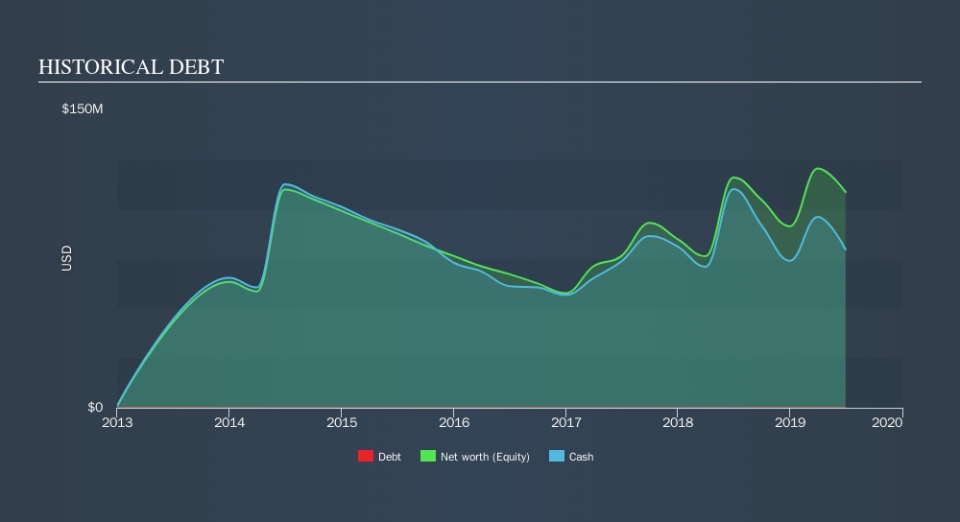Is Kindred Biosciences (NASDAQ:KIN) In A Good Position To Invest In Growth?

There's no doubt that money can be made by owning shares of unprofitable businesses. For example, although software-as-a-service business Salesforce.com lost money for years while it grew recurring revenue, if you held shares since 2005, you'd have done very well indeed. But the harsh reality is that very many loss making companies burn through all their cash and go bankrupt.
Given this risk, we thought we'd take a look at whether Kindred Biosciences (NASDAQ:KIN) shareholders should be worried about its cash burn. For the purposes of this article, cash burn is the annual rate at which an unprofitable company spends cash to fund its growth; its negative free cash flow. We'll start by comparing its cash burn with its cash reserves in order to calculate its cash runway.
View our latest analysis for Kindred Biosciences
When Might Kindred Biosciences Run Out Of Money?
A company's cash runway is calculated by dividing its cash hoard by its cash burn. In June 2019, Kindred Biosciences had US$80m in cash, and was debt-free. Importantly, its cash burn was US$75m over the trailing twelve months. So it had a cash runway of approximately 13 months from June 2019. That's not too bad, but it's fair to say the end of the cash runway is in sight, unless cash burn reduces drastically. You can see how its cash balance has changed over time in the image below.
How Is Kindred Biosciences's Cash Burn Changing Over Time?
Although Kindred Biosciences had revenue of US$3.7m in the last twelve months, its operating revenue was only US$3.7m in that time period. Given how low that operating leverage is, we think it's too early to put much weight on the revenue growth, so we'll focus on how the cash burn is changing, instead. Over the last year its cash burn actually increased by a very significant 99%. Oftentimes, increased cash burn simply means a company is accelerating its business development, but one should always be mindful that this causes the cash runway to shrink. Clearly, however, the crucial factor is whether the company will grow its business going forward. For that reason, it makes a lot of sense to take a look at our analyst forecasts for the company.
How Hard Would It Be For Kindred Biosciences To Raise More Cash For Growth?
Given its cash burn trajectory, Kindred Biosciences shareholders may wish to consider how easily it could raise more cash, despite its solid cash runway. Generally speaking, a listed business can raise new cash through issuing shares or taking on debt. Commonly, a business will sell new shares in itself to raise cash to drive growth. We can compare a company's cash burn to its market capitalisation to get a sense for how many new shares a company would have to issue to fund one year's operations.
Kindred Biosciences has a market capitalisation of US$256m and burnt through US$75m last year, which is 29% of the company's market value. That's not insignificant, and if the company had to sell enough shares to fund another year's growth at the current share price, you'd likely witness fairly costly dilution.
Is Kindred Biosciences's Cash Burn A Worry?
On this analysis of Kindred Biosciences's cash burn, we think its cash runway was reassuring, while its increasing cash burn has us a bit worried. Summing up, we think the Kindred Biosciences's cash burn is a risk, based on the factors we mentioned in this article. For us, it's always important to consider risks around cash burn rates. But investors should look at a whole range of factors when researching a new stock. For example, it could be interesting to see how much the Kindred Biosciences CEO receives in total remuneration.
Of course Kindred Biosciences may not be the best stock to buy. So you may wish to see this free collection of companies boasting high return on equity, or this list of stocks that insiders are buying.
We aim to bring you long-term focused research analysis driven by fundamental data. Note that our analysis may not factor in the latest price-sensitive company announcements or qualitative material.
If you spot an error that warrants correction, please contact the editor at editorial-team@simplywallst.com. This article by Simply Wall St is general in nature. It does not constitute a recommendation to buy or sell any stock, and does not take account of your objectives, or your financial situation. Simply Wall St has no position in the stocks mentioned. Thank you for reading.

 Yahoo Finance
Yahoo Finance 
